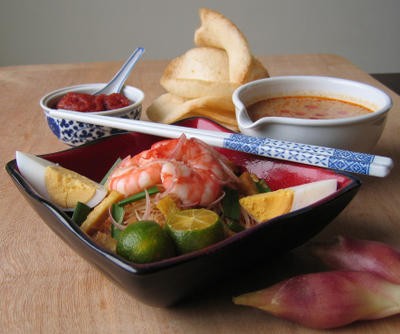Mee Siam
 Despite his robust build and appearance, W really has a fairly sensitive constitution - by which I mean his poor tolerance of spicy food. As much as he loves it, he has a pretty low threshold when it comes to the Scoville stakes, paying dearly every time he indulges in a fashion I don't think I need to go into detail here. I attribute it to his Stateside upbringing; not having been weaned on sambal at a tender age, he never built up an endurance. Nonetheless, like every self-respecting Asian, he's totally addicted to the no pain-no gain hot pepper high, the endorphin rush that's released as tingled nerve endings trick your brain into thinking you're in pain. Amongst the spicy foods W will gladly suffer for, Mee Siam ranks high on the list. This tangily spicy rice vermicelli dish, like many other classics in the Nonya repertoire, blends essentially Malay flavours like belachan (shrimp paste) and coconut milk with unmistakably Chinese accents. In this particular instance, taucheo (salted soy beans) adds intrigue to the rempah (spice paste). Mee Siam is so-named as its spicy, sweet and sour flavour and redolence are somewhat similar to, or influenced by, Thai food. If you're petrified of chillies or are cooking for loved ones who are, reduce the fear (or rather, heat) factor by stripping out the veins and seeds of the fruit - that's where the capsaicin is concentrated. And like many other Nonya dishes, Mee Siam is pretty labour-intensive. However, the rempah, gravy and toppings can all be prepared ahead of time - it's then just a matter of quick assembly when you're ready to tuck in. You can dish everything out attractively into individual bowls, serving the piping hot gravy in a separate jug for people to pour over just before eating - all the better to unleash the heady aroma of the slivered bunga siantan (the beautiful pink ginger buds of the torch ginger plant - an optional, but lovely, touch) that tops the vermicelli. Have fresh chilli sambal and cut kalamansi limes at the table for those who like it hot and/or tart, as well as some keropok (prawn crackers) for sopping up the gravy.
Despite his robust build and appearance, W really has a fairly sensitive constitution - by which I mean his poor tolerance of spicy food. As much as he loves it, he has a pretty low threshold when it comes to the Scoville stakes, paying dearly every time he indulges in a fashion I don't think I need to go into detail here. I attribute it to his Stateside upbringing; not having been weaned on sambal at a tender age, he never built up an endurance. Nonetheless, like every self-respecting Asian, he's totally addicted to the no pain-no gain hot pepper high, the endorphin rush that's released as tingled nerve endings trick your brain into thinking you're in pain. Amongst the spicy foods W will gladly suffer for, Mee Siam ranks high on the list. This tangily spicy rice vermicelli dish, like many other classics in the Nonya repertoire, blends essentially Malay flavours like belachan (shrimp paste) and coconut milk with unmistakably Chinese accents. In this particular instance, taucheo (salted soy beans) adds intrigue to the rempah (spice paste). Mee Siam is so-named as its spicy, sweet and sour flavour and redolence are somewhat similar to, or influenced by, Thai food. If you're petrified of chillies or are cooking for loved ones who are, reduce the fear (or rather, heat) factor by stripping out the veins and seeds of the fruit - that's where the capsaicin is concentrated. And like many other Nonya dishes, Mee Siam is pretty labour-intensive. However, the rempah, gravy and toppings can all be prepared ahead of time - it's then just a matter of quick assembly when you're ready to tuck in. You can dish everything out attractively into individual bowls, serving the piping hot gravy in a separate jug for people to pour over just before eating - all the better to unleash the heady aroma of the slivered bunga siantan (the beautiful pink ginger buds of the torch ginger plant - an optional, but lovely, touch) that tops the vermicelli. Have fresh chilli sambal and cut kalamansi limes at the table for those who like it hot and/or tart, as well as some keropok (prawn crackers) for sopping up the gravy.MEE SIAM
Prawn Stock
*12 large tiger prawns *2 litres water
De-shell and de-vein the prawns. Set them aside. Only the heads and shells are needed for the stock. Place heads and shells in a stockpot. Add 2 litres of water. Bring slowly to the boil, then turn heat down so water simmers. Simmer for 1 hr, or until water is reduced to 1 litre. Strain. Set aside.
Rempah
*10 shallots, peeled and minced *6 fresh red chillies, de-seeded and minced *6 dried red chillies, de-seeded, soaked till soft, drained and minced *2 lemongrass stalks, tender inner stems only, minced *6 candlenuts, chopped *1 heaped Tbsp belachan (shrimp paste)
Pound together all the ingredients listed except for the belachan. Wrap belachan in a small square of aluminium foil. Toast package in a small dry pan over low heat till aromatic. Unwrap, crumble into the rempah, incorporate. Set aside.
Gravy
*4 Tbsp peanut oil *100gm dried shrimp, soaked till soft, drained and finely minced *3 heaped Tbsp taucheo (salted soy beans), lightly crushed *1 litre prawn stock (from above)*4 Tbsp dried tamarind pulp dissolved in 1 cup water, sieved, tamarind water reserved *2 Tbsp gula melaka (palm sugar), or more *1 red onion, halved and finely sliced *600ml coconut milk, preferably freshly extracted
Heat oil in a large heavy saucepan over medium heat. When fairly hot, add the rempah along with the finely minced dried shrimp. Turn heat down. Patiently stir-fry the mixture until it turns a deep terracotta colour and the oil separates - at least 30 minutes. Do not leave the pan unattended. When the paste is correctly cooked, add the taucheo. Stir for 1 minute. Now scoop out a third of the paste into a bowl and set the bowl aside (this will be used to cook and flavour the rice vermicelli later). To the remaining paste in the pan, add the prawn stock made earlier. Bring to a simmer, then add half the quantity of tamarind water specified, sugar and onion. Simmer for 30 minutes. Now add the coconut milk and simmer for a further 10 minutes, or till slightly thickened. Adjust seasoning to taste with the reserved tamarind water and more sugar (it is unlikely you'll need any salt). Turn heat off, cover pan, set aside.
Toppings
*12 large tiger prawns, de-shelled and de-veined (from making the prawn stock), poached 2 minutes in simmering salted water till cooked, drained, sliced lengthwise *4 eggs, hard-boiled, peeled, quartered *A large handful of ku chai (Chinese chives; you can substitute chives or scallions), green section only, snipped into 2cm lengths *1 square taukua (firm tofu), well drained, sliced into 2cm strips, deep-fried in a vat of hot peanut oil till golden brown, drained on paper towels *4 kalamansi limes, halved *1 ginger flower bud, pink petals only, slivered (optional)
Prepare all the toppings as described ahead of serving. Set aside.
*200gm beehoon (dried rice vermicelli)
*Fried rempah (reserved quantity from making gravy earlier)
*250ml water
*Large handful of bean sprouts, topped and tailed
When ready to eat, soak the dried rice vermicelli in a large bowl of tepid water for 5 minutes. Drain and set aside. Place the reserved quantity of fried rempah (set aside from making the gravy earlier) in a wok or large frying pan over medium heat. Add the water. Bring to the boil. Add beansprouts. Stir and cook for a minute. Add the rice vermicelli, turn down the heat, and toss repeatedly with long cooking chopsticks to evenly mix everything. When the pan is fairly dry, dish the vermicelli out into individual serving bowls. Top each portion with prawn slices, egg quarters, ku chai, taukwa, a lime halve, and a scattering of ginger flower bud slivers.
To Serve
*Fresh chilli sambal
*Keropok (prawn crackers)
Bring out the dressed bowls of vermicelli along with dishes of fresh chilli sambal, keropok, and more lime halves. Bring the saucepan of gravy back to the boil. Pour into a jug and bring to the table. Pour gravy over vermicelli just before eating. Let diners add squeeze of lime and chilli sambal to taste.
Serves 4 to 6.


12 Comments:
Swooningly fabulous mee siam! I hafta take lessons from you on how to make this
thanks s! anytime, just name a date and place ;)
I'm drooling just reading your descriptions and looking at your photos.
Like W my D and I are both delicate flowers so when I try it I'll be sure to remove seeds and ribs.
I could look at your site forever - the pictures are so beautiful.
Right now I'm in the process of writing a cookbook of family favorite recipes and stories that they remind me of. I'm taking my own photos and feeling very inadequate as I look at yours.
Hello
noticed that with your previous recipe for Laksa (which is very asian in origin - you named a few countries). Is there a specific nation which Mee Siam is most akin to? The name Siam would suggest Thailand - but i had not (or think i have not) seem to come across examples from them. I have in fact seen Mee Siam (i am probably an ignorant and less worldly travelled being) only in Singapore & Malaysia?
I would love to know if you find time to answer.. thank u
I love Mee Siam especially with the taucheo sauce. My friend's mum does the best Mee Siam - it's her signature dish which we get to eat during their annual Christmas party. She has declined to share her recipe with me as it's a family recipe.
Since then I have been collecting Mee Siam recipes so I can try and replicate hers one day when I am free. Must add yours to my collection and try it one day.
wahh looks damn good!
really appreciate you giving such detailed instructions for the recipes, will definitely try them when i become more acquainted with cooking.
oh oh and by the way is the bunga siantan the thing they use in chinese rojak? where do you get it from?
incredible looking photo, drool collecting at the sides of mouth - must leave site IMMEDIATELY before keyboard on laptop is damaged!!! :)
Wow I want to eat this right now! I already had a hankering for some sambal and now it is desperate with no way to cure it....
I am going to make this for sure...
and I LOVE HOT foods!
hi amy, the feeling is mutual ;)
hi augustusgloop, thanks...glad you like the pictures ;)
hi boolicious, have fun making the mee siam...
hi gwenda, thanks :) yes, ginger bud/bunga siantan is what they use in chinese rojak...you can find it at most wet markets - i get mine from tekka market.
hi eatzycath, :) you're funny...
hi clare, thanks! you're very kind
hi caracola, thanks! good to hear from you again
love the photo of the mee siam! beautifully presented
just tried it today for a hari raya party in london - went down a treat!
cheers
Post a Comment
<< Home